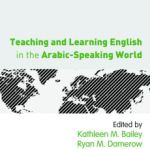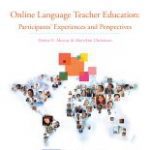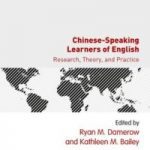Refine Search
By Resource Type
By Resource Tags
(Download this publication here: http://www.tirfonline.org/wp-content/uploads/2021/10/LEiR_CEFR.pdf)
A recent search for the term “CEFR” (the Common European Framework of Reference for Languages) on Google Scholar gave the following results: approximately 28,000 hits with no time frame; 12,700 hits since 2015; approximately 3,900 hits in 2018; and approximately 700 hits in the first three months of 2019. In other words, there is an abundance of work on the CEFR – an embarrassment of riches perhaps, that makes it very difficult for any single publication to summarize all the research that has been done, and that is being done, on the CEFR.
Examples of CEFR research published in 2019 include the paper by Afir, Hamid, and Renshaw on the use of the CEFR in Malaysia. In that paper, the authors start by stating that the CEFR “has emerged as a global policy in language education which has been ‘borrowed’ by nations across the world” (p. 1). That notion of ‘borrowing’ refers to the fact that the CEFR was originally designed by Europeans for Europeans, but now appears to have taken on a life of its own, being referred to in teaching, learning, and testing contexts far away from Europe, not only geographically far-removed in space and time, but also far-removed in terms of histories, languages, and cultures.
In a paper published in 2018, also on the implementation of the CEFR in Malaysia, Azia, Rashid, and Zainudin concluded that “the implementation of CEFR in Malaysia still needs to be improved. All the stakeholders need to be properly synchronised, aware of their responsibility and updated with the latest information” (2018, p. 415, emphasis added). Those two papers (and others) on the CEFR in Malaysia highlight one of the challenges of employing the Framework, i.e., the context – geographical, linguistic, cultural, educational, etc. Another challenge relates to being “updated with the latest information” on the CEFR, as so much CEFR-related research is being done, and so many papers on the Framework are being published.
Other papers reiterate this recurring theme of contextual challenges. For example, working with Spanish learners of English in Spain, Díez-Bedmar (2018) found that “despite the current importance of the CEFR in the learning, teaching, and assessment of languages, limitations arise in the use of the CEFR descriptors, which are also present in the European Language Portfolio (ELP)” (p. 199, emphasis added).
Another context for CEFR research has been Canada. For example, Arnott, Brogden, Faez, Péguret, Piccardo, et al. (2017) proposed a research agenda for the CEFR in Canada. In their paper, the authors conclude with a series of questions, including the following:
- “What policies currently exist or might need to be created in order to support CEFR use within and across the provinces at all three levels of education for a variety of languages?
- What professional development opportunities are currently being offered, and what further types of scaffolding are needed to support language teachers?
- How is the CEFR currently being used, and how might it be used to greater advantage in order to enhance language learning?
- How do students experience CEFR-informed instruction, and what types of impact does it have?” (Arnott, Brogden, Faez, Péguret, Piccardo et al., 2017, p. 47)
On the basis of the third question above – “How is the CEFR currently being used, and how might it be used to greater advantage in order to enhance language learning?” – TIRF commissioned Professor Enrica Piccardo, Professor of Applied Linguistics and Language Education at OISE (University of Toronto), to author the second paper in TIRF’s LEiR series.
TIRF remains grateful for partnering with Laureate Languages to commission The Common European Framework of Reference (CEFR) in Language Education: Past, Present, and Future, and thanks Prof. Piccardo’s diligence in authoring the paper. Please click here to access the paper.
– Andy Curtis, Chair of TIRF’s Publications Committee
As part of TIRF’s mission to sponsor and disseminate cutting edge research into language education, we have commissioned a set of papers on different aspects of handheld language learning, to be published in the first instance as free downloads on our website. Each of these papers aims to summarize the state of our knowledge concerning the use and effects of handheld devices on the outcomes of English language learning.
More information on our mobile-assisted assisted language learning commissioned papers can be found by clicking here.
New Ways to Support EMI Teachers, Students, and Schools
English-Medium Instruction (EMI) is the use of the English language to teach academic subjects in settings where English is not the most common language of education. Over the past two decades, the number of schools with EMI curricula has expanded dramatically because English is now essential for success in a variety of arenas, including politics, economics, technology, science, medicine, and media.
Context: EMI is experiencing growth in public sectors globally and is no longer limited to students at elite private academies and universities. However, research shows that issues persist in effectively implementing EMI in schools across all levels due to the complex nature of studying academic curriculum in a second or third language.
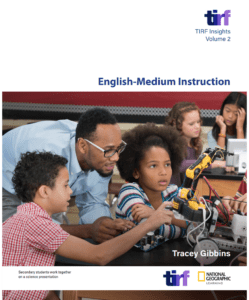 What the Research Says: A growing number of EMI programs encourage teachers to take advantage of students’ first language (L1) to deliver new skills and content in English. In this way, two languages are used to process content and support students in becoming fully bilingual and academically successful.
What the Research Says: A growing number of EMI programs encourage teachers to take advantage of students’ first language (L1) to deliver new skills and content in English. In this way, two languages are used to process content and support students in becoming fully bilingual and academically successful.
Why it Matters: English is already the leading language of technology and medicine and is the business lingua franca. Young people are required to obtain a level of English proficiency not needed for previous generations. EMI can be foundational in the development of English language skills across the many disciplines required in modern education. Students with greater English proficiency have more university choices and greater career flexibility.
What’s Next: Globalization and EMI are interlinked: International students continue to look for programs providing EMI while English-medium institutions seek these students as a source of income and prestige. EMI will also continue to expand in primary and secondary sectors, in both private and public contexts. Research shows that students who begin an EMI program early in their education are often more successful throughout their learning in English-medium schools.
Read the Report: In this recent report from TIRF and National Geographic Learning, author Tracey Gibbins sets the backdrop of EMI in today’s educational arena and shares where this approach to language education is heading. This paper is available in multiple languages. Use the following links to download the version of the paper you wish to read:
About the “TIRF Insights” Series: The “TIRF Insights” series profiles recent research in the field of English Language Teaching (ELT) in a practical and accessible format. Our publication is written for parents, teachers, school leaders, and all student advocates who want to review recent educational trends in a nonacademic way.
Click here to download the English version of TIRF Insights: English-Medium Instruction.
Calls to Action: Here is a set of discussion questions that will help you and your team take next steps toward adopting, implementing, and/or furthering EMI at your institution:
- What are some of the challenges learners face in EMI classrooms? Is there a discrepancy in English language proficiency levels among students in classrooms in our community? Are the materials used with our students suitable for all levels of English proficiency?
- Which cultural backgrounds are reflected in our school or community’s student body? How does this cultural mix play a role in our school or community’s EMI approach? How do we currently include and support all students? What more can we do?
- How can educators support one another during EMI adoption? Which teachers feel challenged, and by which issues? How can administrators support these differing needs?
- We know there is often a performance gap in EMI classes between students with lower levels of English proficiency and those with greater proficiency. How can educators support both types of students to decrease the gap and provide appropriate academic instruction?
- Are there additional equity and inclusion issues present in the classroom? How can these be identified and addressed?
In March 2014, TIRF released its first ever book-length publication. Teaching and Learning English in the Arabic-Speaking World is co-published by TIRF and Routledge/Taylor & Francis. This book is the first in the series entitled, “Global Research on Teaching and Learning English.”
Co-edited by Kathi Bailey (TIRF President & Chairman of the Board of Trustees) and Ryan Damerow (TIRF’s Executive Assistant), this volume includes contributions from TIRF’s Sheikh Nahayan Fellows and several individuals who were instrumental in developing the relationship between the Foundation and Sheikh Nahayan Bin Mubarak Al Nahayan. The book is dedicated to Sheikh Nahayan, as he was the person responsible for funding the Sheikh Nahayan Fellowships. We remain ever grateful for his support.
For more information about the book, including how to order, please click here. Please note that all royalties earned from the sale of the book will be donated to TIRF to help fund our programs.
Some Emerging Principles for Mobile-assisted Language Learning
For the main paper, click here.
Glenn Stockwell, Professor, Waseda University
Philip Hubbard, Senior Lecturer and Director of English for Foreign Students, Stanford University Language Center
Executive Summary: The steadily increasing access to sophisticated but affordable portable technologies over the past several years has brought with it a body of research into using these technologies for learning in both formal and informal contexts. It is not surprising, then, that language teachers have also adopted mobile technologies into their individual teaching and learning contexts. This paper first examines recent studies from the mobile-assisted language learning (MALL) literature, exploring the issues that emerge from this body of research through a framework distinguishing physical, pedagogical, and psycho-social dimensions. Recognizing not only the contributions but also the limitations of existing MALL literature, it then identifies a number of findings from the closely allied fields of mobile learning (ML) and computer-assisted language learning (CALL) that can inform both research and practice in MALL. Drawing from all three sources (MALL, ML, and CALL), the paper proposes ten general principles to guide teachers, learners, administrators, employers, and other stakeholders in the challenge of effectively integrating mobile devices and tasks into language learning environments. The paper concludes with a case study showing how each of the principles described have been applied in an actual mobile language learning context.
 Discussion of this paper provided by: Tarana Patel, Founder & Educator, learnEd, India
Discussion of this paper provided by: Tarana Patel, Founder & Educator, learnEd, India
Read the discussion by clicking here.
Discussion of this paper provided by: Simone Smala, Professor, The University of Queensland, Brisbane, Australia
Read the discussion by clicking here.
Terms of Use and Disclaimer: TIRF is providing this information as a service to our constituents, and no endorsement by TIRF of the ideas presented in this paper is intended or implied. The information is made available free of charge and may be shared, with proper attribution. However, the papers may not be reprinted without express written permission from TIRF.
In March 2015, we published our second full-length book in cooperation with Routledge/Taylor & Francis. This book is the second in the series entitled, “Global Research on Teaching and Learning English.”
The volume is co-edited by MaryAnn Christison (TIRF Trustee & Chair of TIRF’s Research Advisory Comittee), Donna Christian (TIRF Trustee & Treasurer-Secretary), Patricia Duff (Former TIRF Trustee), and Nina Spada (TIRF Grantee). This grammar-focused publication is dedicated to Dr. Betty Azar for her support during TIRF’s early years, as she was a major supporter of our grant programs. The volume features a collection of work that resulted from TIRF grants, which were awarded to individuals whose research focused on grammar in language education.
For more information about the book, including how to order, please click here. Please note that all royalties earned from the sale of the book will be donated to TIRF to help fund our programs.
English for Specific Purposes (ESP), as a field within language education, has been evolving constantly since its inception. And as COVID-19 has affected our industry in a multitude of ways – many of which are known to us now yet many others are likely on the horizon – ESP is inevitably undergoing further changes in the near future.
Topics centered on ESP, such as key issues in the field, what we currently know, what the future holds, and what the implications are for various types of stakeholders, are all addressed in the latest installment to the TIRF Language Education in Review (LEiR) series. Authored by TIRF Trustee and TIRF Publications Advisory Committee Chair Dr. Andy Curtis, Language Education in Review: English for Specific Purposes, is free to download on TIRF’s website.
The primary readership for the entire series, regardless of the topics of individual papers, is non-academic. Papers are intended for policymakers and language education professionals in leadership and management roles, who need to be aware of trends and recent findings, for decision-making purposes, but who do not necessarily teach, conduct research, publish, or present.
TIRF is appreciative for its partnership with Laureate Languages to commission this latest LEiR paper and is grateful for Dr. Curtis’ efforts in authoring the publication.
Please click here to access this paper.
In March 2016, we released the third volume in the series entitled, “Global Research on Teaching and Learning English,” which is co-published with Routledge/Taylor & Francis.
This volume is co-edited by TIRF Trustees JoAnn (Jodi) Crandall and MaryAnn Christison. It presents new empirical research situated in different contexts around the world, including Canada, Denmark, Israel, Japan, Korea, Qatar, Sudan, and the U.S. It is framed by the volume editors’ insightful overview and analyses of previous and ongoing work in a variety of related domains and an epilogue by David Nunan. The chapter studies are organized around three themes: teacher identity in ESL/EFL teacher education and professional development programs, second language teacher education programs for diverse contexts, and professional development for diverse contexts.
For more information about the book, including how to order, please click here. Please note that all royalties earned from the sale of the book will be donated to TIRF to help fund our programs.
TIRF is pleased to announce that a Chinese translation of The Impact of English and Plurilingualism in Global Corporations has appeared in the 2010 English Career, Volumes 33 and 34 (June and October), a magazine which is published in Taiwan. We are grateful to the editors and to Ms. Kuan-Ling Lin and Mr. Chao-Min Hsu for the translation.
TIRF’s 2017 commissioned study is titled, Online Language Teacher Education: Participants’ Experiences and Perspectives. This paper is a follow-up study to TIRF’s 2013 study, A Case for Online English Language Teacher Education (see below for further information).
We would like to extend our sincere gratitude to the co-authors of this study, Dr. Denise Murray (Professor Emerita at Maquarie University, Sydney, Australia & at San José State University, San José, California, USA) and Dr. MaryAnn Christison (Professor, Department of Linguistics and the Urban Institute for Teacher Education at the University of Utah in Salt Lake City, Utah). This research investigates the experiences and perceptions of students and instructors in OLTE courses and programs.
- Click here to download the paper.
- To download the Executive Summary, click here.
TIRF Insights: Social and Emotional Learning is available in four languages: Arabic, Chinese (Simplified), English, and Spanish.
This paper, authored by Katherine (Kath) Stannett, investigates social and emotional learning (SEL) against the backdrop of the COVID-19 pandemic and consequent disrupted education and learning loss.
Recent research suggests that the COVID-19 pandemic has led to disrupted education, learning loss, and the wide-scale use of hybrid and online teaching and learning. The pandemic has also revealed and underscored a need to address not only stude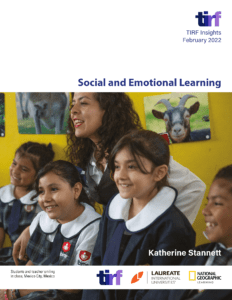 nts’ academic skills but also their social and emotional skills.
nts’ academic skills but also their social and emotional skills.
This paper is made available to the public for free. Use these links to access the publication:
TIRF is pleased to have worked with author Kath Stannett, an England-based teacher trainer and materials writer, and in collaboration with Laureate International Universities and National Geographic Learning, to produce this first paper in the “TIRF Insights” series. This series was formerly known as “TIRF Language Education in Review.”
Via “TIRF Insights,” the Foundation profiles recent research in the field of English Language Teaching in a practical and accessible format. Our publication is written for parents, teachers, school leaders, and all student advocates who want to review recent educational trends in a nonacademic way.
Click here to download the English version of TIRF Insights: Social Emotional Learning.
Mobile Learning for Languages: Can the Past Speak to the Future?
For the main paper, click here.
 John Traxler, Professor of Mobile Learning and Learning Lab Director, University of Wolverhampton
John Traxler, Professor of Mobile Learning and Learning Lab Director, University of Wolverhampton
Executive Summary: This paper explores the past decade of mobile learning projects, policies, research, and conceptualising and asks about its relevance to the future as it might apply to language learning. The paper provides a very broad categorization of mobile learning in order to identify pedagogic possibilities for language learning, but it moves on to ask about the changing nature and authority of language and learning. There are nevertheless practical lessons to be learnt.
Discussion of this paper provided by: Shannon Sauro, Associate Professor, Department of Culture, Languages & Media, Malmö University, Sweden
Read the discussion by clicking here.
Discussion of this paper provided by: David L. Chiesa, US Department of State – Senior English Language Fellow, Coordinator, Beijing Normal University, China
Read the discussion by clicking here.
Terms of Use and Disclaimer: TIRF is providing this information as a service to our constituents, and no endorsement by TIRF of the ideas presented in this paper is intended or implied. The information is made available free of charge and may be shared, with proper attribution. However, the papers may not be reprinted without express written permission from TIRF.
The seventh volume in the “Global Research on Teaching and Learning English” features chapters with original research written by internationally recognized scholars and TIRF Doctoral Dissertation Grant awardees. The volume addresses the crucial and growing need for research-based conversations on the contexts, environments, goals, and measures of success for Chinese-speaking learners of English. It includes sections on language assessment, perceptions in university contexts, and technology, especially in relation to young learners, in order to promote in-depth discussion of the teaching and learning of English for native speakers of Chinese.
The13 research-based chapters in Chinese-Speaking Learners of English: Research, Theory, and Practice discuss topics such as the impact and implications of using emerging assessment tools; the increase in English for Specific Purposes (ESP) courses; academic speaking and writing; and teaching in an online or hybrid environment. Throughout the book, the authors draw on their knowledge of their multiple contexts, as well as their learners’ needs and goals.
This volume is co-edited by Ryan Damerow, TIRF’s Chief Operating Officer, and Dr. Kathi Bailey, TIRF President is now available for purchase online.
In February 2017, we released the fourth volume in the series entitled, “Global Research on Teaching and Learning English,” which is co-published with Routledge/Taylor & Francis.
This volume features a carefully balanced set of studies and practitioner research projects carried out in various learning contexts around the world. Digital Language Learning and Teaching highlights cutting-edge research in the use of digital learning technologies in language classrooms and in online learning. Providing an overview of recent developments in the application of educational technology to language learning and teaching, it looks at the experience of researchers and practitioners in both formal and informal (self-study) learning contexts, bringing readers up-to-date with this rapidly changing field and the latest developments in research, theory, and practice at both classroom and education system levels. The volume is co-edited by Michael Carrier (TIRF Trustee), Ryan M. Damerow (TIRF Chief Operating Officer), and Kathleen M. Bailey (TIRF President).
For more information about the book, including how to order, please click here. Please note that all royalties earned from the sale of the book will be donated to TIRF to help fund our programs.
TIRF’s first publication was in 2009 and is entitled, The Impact of English and Plurilingualism in Global Corporations. The full version of the report is available here.
To see a summary of this report, please click here.
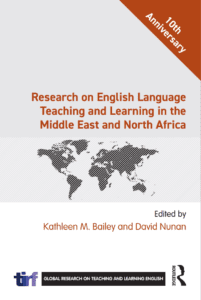 The 10th volume in the TIRF-Routledge series, this book features research on the teaching and learning of English in the Middle East and North Africa (MENA). With chapters written by TIRF Doctoral Dissertation Grant awardees and internationally known scholars, the volume addresses contemporary challenges and considerations to teaching English in the MENA context. With empirical research covering a wide range of under-studied contexts, this book provides important insights and future directions to improve research and instruction. Offering up-to-date research at the primary, secondary, and post-secondary levels, this volume is an essential resource for language education programs and pre-service teachers.
The 10th volume in the TIRF-Routledge series, this book features research on the teaching and learning of English in the Middle East and North Africa (MENA). With chapters written by TIRF Doctoral Dissertation Grant awardees and internationally known scholars, the volume addresses contemporary challenges and considerations to teaching English in the MENA context. With empirical research covering a wide range of under-studied contexts, this book provides important insights and future directions to improve research and instruction. Offering up-to-date research at the primary, secondary, and post-secondary levels, this volume is an essential resource for language education programs and pre-service teachers.
This book has been co-edited by TIRF Trustees Dr. Kathi Bailey and Dr. David Nunan. It is featured in the “Global Research on English Language Teaching and Learning.”
If you are interested in ordering the book, please click here to visit Routledge’s website.
We are pleased to announce the publication of its most recent commissioned paper entitled, English at Work: An Analysis of Case Reports about English Language Training for the 21st-century Workforce, which was co-authored by Anthony Fitzpatrick and Robert O’Dowd.
- Click here to download the paper. (For a printer-friendly version, click here.)
- To download a business-oriented summary, please click here.
- To download the executive summary, please click here.
- To browse and download case reports that were summarized in TIRF’s English at Work paper, go here.
Re-skilling Language Learners for a Mobile World
For the main paper, click here.
 Agnes Kukulska-Hulme, Professor of Learning Technology and Communication, The Open University
Agnes Kukulska-Hulme, Professor of Learning Technology and Communication, The Open University
Executive Summary: Ubiquitous access to mobile phones and other portable devices means that language learning increasingly straddles classroom-based learning and learning outside the classroom, in virtual spaces and out in the world. We know from studies of emergent learner-led practices that foreign language study can be enriched through easy access to resources selected to suit individual interests or needs. Yet learners’ choices seem largely determined by what they happen to come across, rather than knowledge about which language skills are best improved through mobile learning. Existing mobile applications often fail to exploit connections between life and learning. This paper suggests which language skills can be enhanced through mobile learning and how learner-technology interaction supports that development, particularly opportunities for learners to extend or practice their communication with others. The paper also suggests that new skills may be required in relation to the next generation of wearable devices and increasingly instrumented, technology-rich surroundings where use of mobile technology integrates with other tools, resources, and social networks that continue to challenge traditional knowledge and skills.
Discussion of this paper provided by: Richard Boyum, University Partnership and Grants Evaluation Coordinator for Afghanistan and Pakistan, US State Department, USA
Read the discussion by clicking here.
Discussion of this paper provided by: Sky Lantz-Wagner, ESL Instructor, University of Dayton, USA
Read the discussion by clicking here.
Terms of Use and Disclaimer: TIRF is providing this information as a service to our constituents, and no endorsement by TIRF of the ideas presented in this paper is intended or implied. The information is made available free of charge and may be shared, with proper attribution. However, the papers may not be reprinted without express written permission from TIRF.
Beyond the Classroom: Mobile Learning the Wider World
For the main page, click here.
 Ken Beatty, Professor of TESOL, Anaheim University
Ken Beatty, Professor of TESOL, Anaheim University
Executive Summary: Mobile learning has extended opportunities for making teaching and learning available beyond the traditional classroom. Associated technologies, software programs, and internet access have enfranchised many students who previously had little access to quality teaching. However, a paradigm shift has occurred in which learners are turning to new mobile learning opportunities to supplant traditional teaching as virtual extensions of earlier self-help books, phrase books, and audio-based language learning programs. Audio translation apps, augmented reality, and just-in-time learning approaches are providing alternatives to those with neither access nor time to learn a language. This paper examines the theoretical underpinnings of a range of technologies and applications, contrasting them with the traditional classroom and imagining the future of mobile language teaching and learning and the impact it will have on policymakers, teachers, employers, and learners.
Discussion of this paper provided by: Leonardo A. Mercado, Academic Director, Instituto Cultural Peruano Norteamericano (ICPNA), Peru
Read Leonardo A. Mercado’s discussion of this paper by clicking here.
Discussion of this paper provided by: Joyce Wangia, Director, Centre for Institutional Based Programmes, Kenyatta University, Kenya
Read Joyce Wangia’s discussion of this paper by clicking here.
Terms of Use and Disclaimer: TIRF is providing this information as a service to our constituents, and no endorsement by TIRF of the ideas presented in this paper is intended or implied. The information is made available free of charge and may be shared, with proper attribution. However, the papers may not be reprinted without express written permission from TIRF.
The FreeBook TIRF has co-published with Routledge features one chapter in each of the six previously published books in the “Global Research in Teaching and Learning English” series.
To download the FreeBook, click here.



